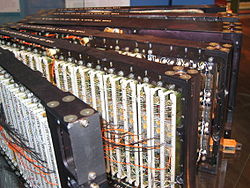- Datasaab
-
Datasaab was the computer division of and later a separate company spun off from aircraft manufacturer Saab in Linköping, Sweden. Its history dates back to December 1954, when Saab got a license to build its own copy of BESK, an early Swedish computer design using vacuum tubes, from Matematikmaskinnämnden (the Swedish governmental board for mathematical machinery). This clone was completed in 1957 and was named SARA. Its computing power was needed for design calculations for the next generation jet fighter Saab 37 Viggen.
Intending to develop a navigational computer to place in an airplane, a team led by Viggo Wentzel came up with an all transistorized prototype computer named D2, completed in 1960, which came to define the company's activities in the following two decades. This development followed two lines. The main purpose was the development of a navigational computer for Viggen. A spinoff was the production of a line of civilian mini and mainframe computers for the commercial market.
The military navigational computer CK37 was completed in 1971 and used in Viggen.
The first civilian model D21 (1962) was sold to several countries and some 30 units were built. After that, several versions with names like D22 (1966), D220, D23, D5, D15, and D16 were developed. When the Swedish government needed 20 computers in the 1960s to calculate taxes, an evaluation between Saab's and IBM's machines proved Saab's better. Later the D5s were used to set up the first and largest bank terminal system for the Nordic banks, a system which was partly in use until the late 1980s.
In 1971, technologies from Standard Radio & Telefon AB (SRT) and Saab were combined to form Stansaab AS, a joint venture that also included the state-owned Swedish Development Company. The company’s primary focus was systems for real-time data applied to commercial and aviation applications.[1]
In 1975, the D23 system was seriously delayed and the solution was a joint company with Sperry UNIVAC. In 1978, this company merged with a division of Saab and became Datasaab.[2] It was later owned by Ericsson, Nokia and ICL.[3]
When Intel sued the competitor UMC for patent infringement over technologies including microcode updates of processors and different parts of the processor working asynchronously, UMC could point to an awarded paper describing how these technologies had been used in the D23 already in 1972. Since Intel's patents were from 1978, that paper would prove prior art and imply that the patents never should have been granted at all. The case was later dropped.
The academic computer society Lysator at Linköping University was founded in 1973 when a donation of an old used D21 was arranged. The company's history has been documented by members of its veteran society, Datasaabs Vänner ("Friends of Datasaab"), founded in 1993 to document and spread information about the computer history of Sweden, with focus on the region of Linköping and Datasaab. The society has documented the Datasaab history in five books, and documents and pictures of computer systems and products developed and produced by Datasaab are presented at the society homepage. Since 2004 many Datasaab computers are exhibited at the IT-ceum computer museum in Linköping.
After a series of mergers, the name Datasaab became connected with an incident of illegal technology transfer to the Soviet Union in the late 1970s. This is summarized in a chapter of the book Techno-Bandits (1984).[4] A 1973 bid for tender for a civilian air traffic control system at the airports in Moscow, Kiev, and Mineralnye Vody was won by Swedish supplier Stansaab. A contract between Stansaab and Aeroflot was signed in September 1975. However, parts of the delivered system relied on components from the U.S.A., for which the Swedes couldn't get the necessary export licenses. So they bought U.S. components, relabeled them and smuggled them to Moscow using Soviet diplomats. In 1978, Stansaab changed its name to Datasaab. Allegedly the air traffic control system did support the Soviet invasion of Afghanistan in December 1979. The smuggling operation was uncovered in October 1980, known as "the Datasaab affair" (Datasaabaffären). In early 1981, Datasaab was acquired by Ericsson and became its computing division Ericsson Information Systems. In April 1984 Ericsson was fined US$3.12 million for breach of U.S. export controls, and agreed to pay.
References
- ^ "Flightglobal archive 1972". http://www.flightglobal.com/pdfarchive/view/1972/1972%20-%203354.html. Retrieved 2008-10-29.
- ^ "Short history of SRT, Stansaab and Datasaab" (in Swedish). http://www.veteranklubbenalfa.se/veteran/foretag.htm. Retrieved 2008-10-29.
- ^ "CBRonline". Computergram. http://www.cbronline.com/news/now_icl_sells_the_old_alfaskop_business_on_to_wyse. Retrieved 2008-10-29.
- ^ Linda Melvern, Nick Anning, David Hebditch, Techno-Bandits : how the Soviets are stealing America's high-tech future (1984) Boston : Houghton Mifflin, ISBN 0-395-36066-8, Swedish translation by Bo Kage Carlson the same year, Teknobanditerna : om smuggling av högteknologi från väst till öst, Stockholm : Svenska Dagbladet, ISBN 91-7738-064-9
External links
Categories:- Defunct companies of Sweden
- Defunct computer hardware companies
- Saab
Wikimedia Foundation. 2010.

